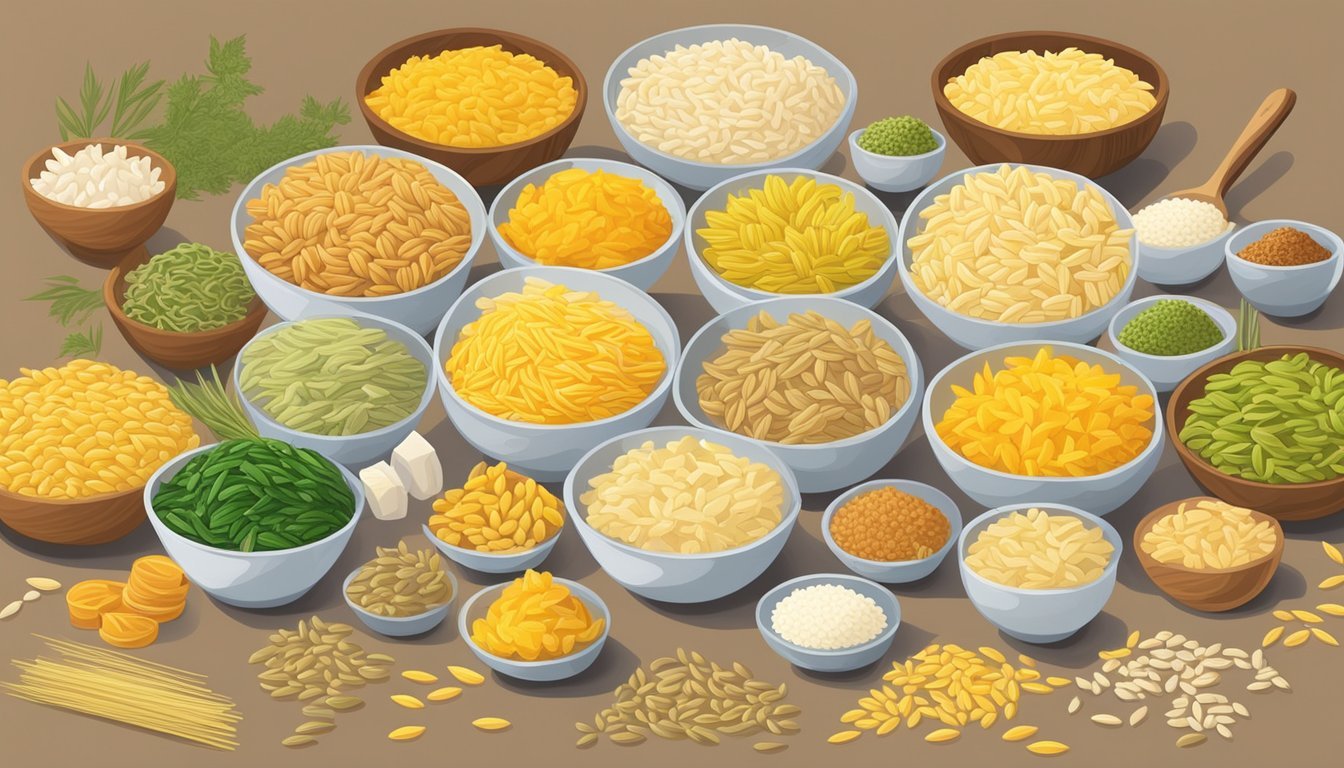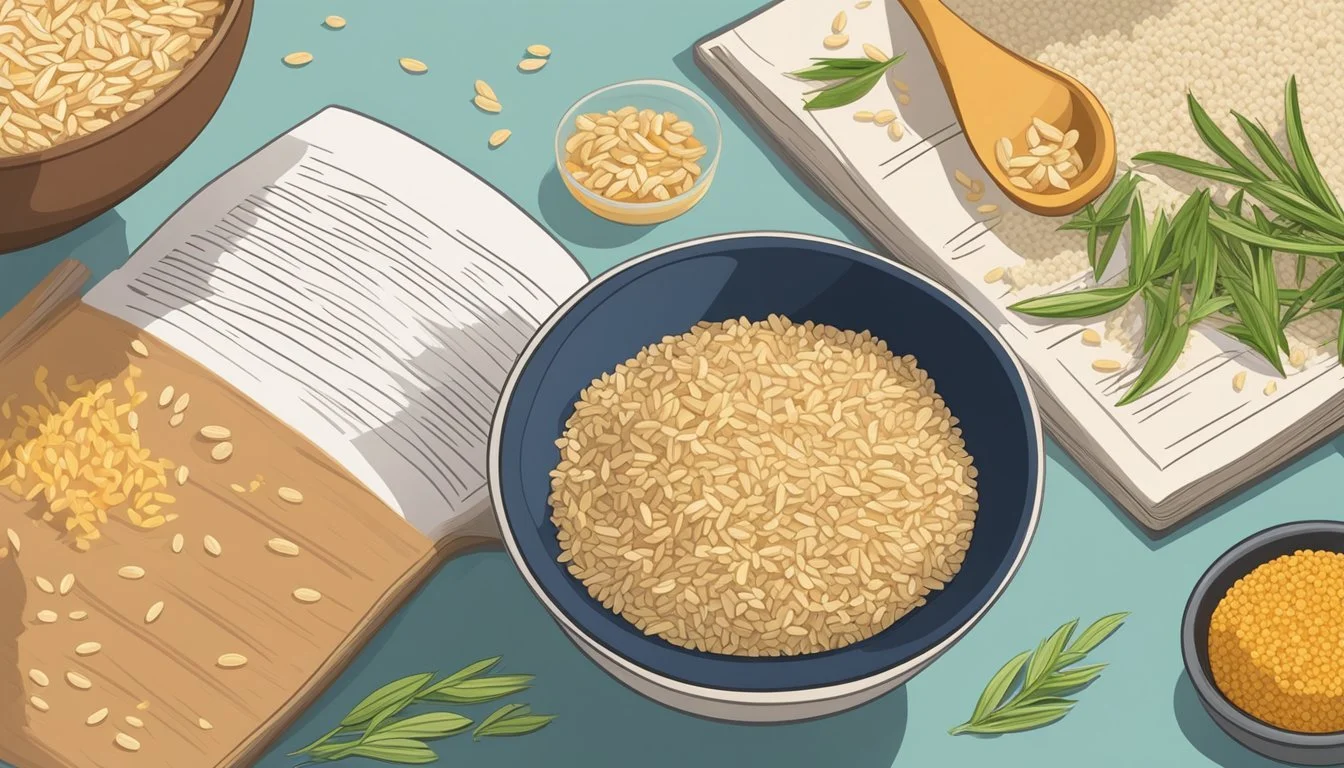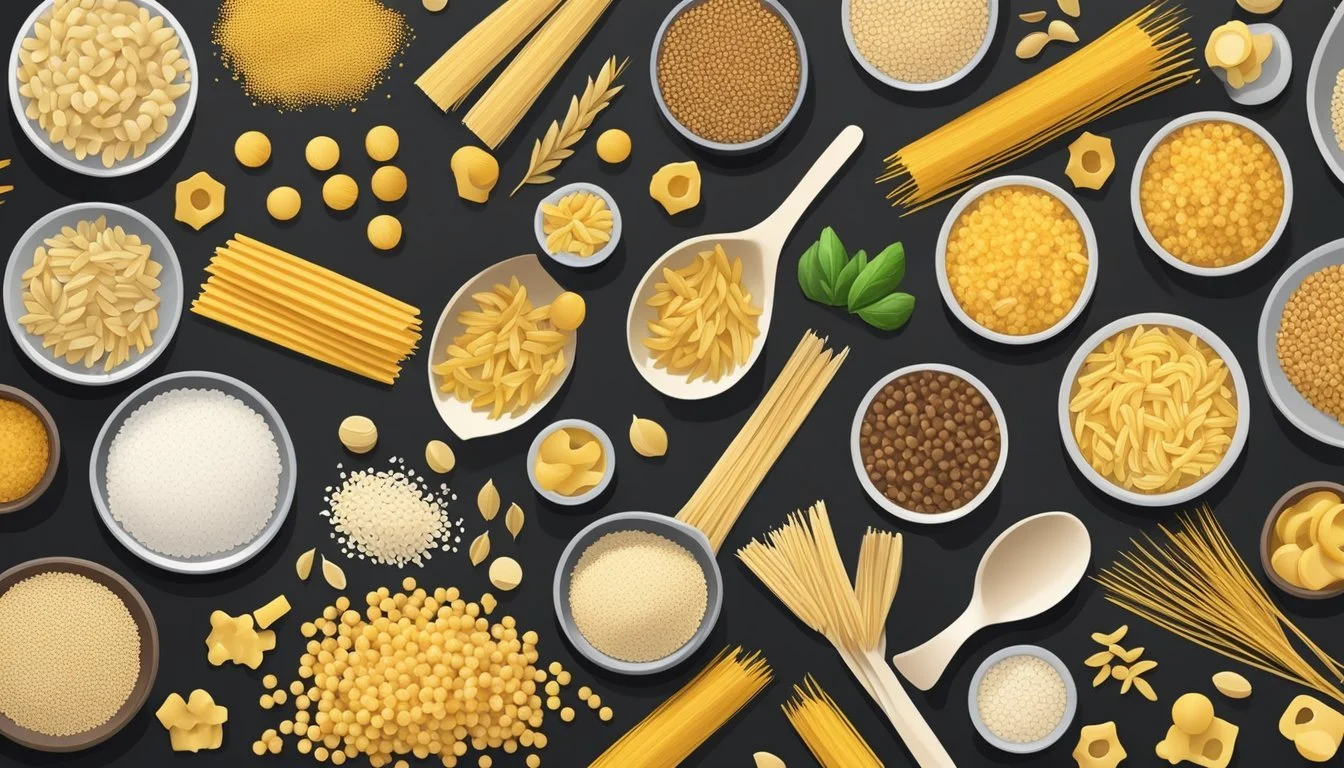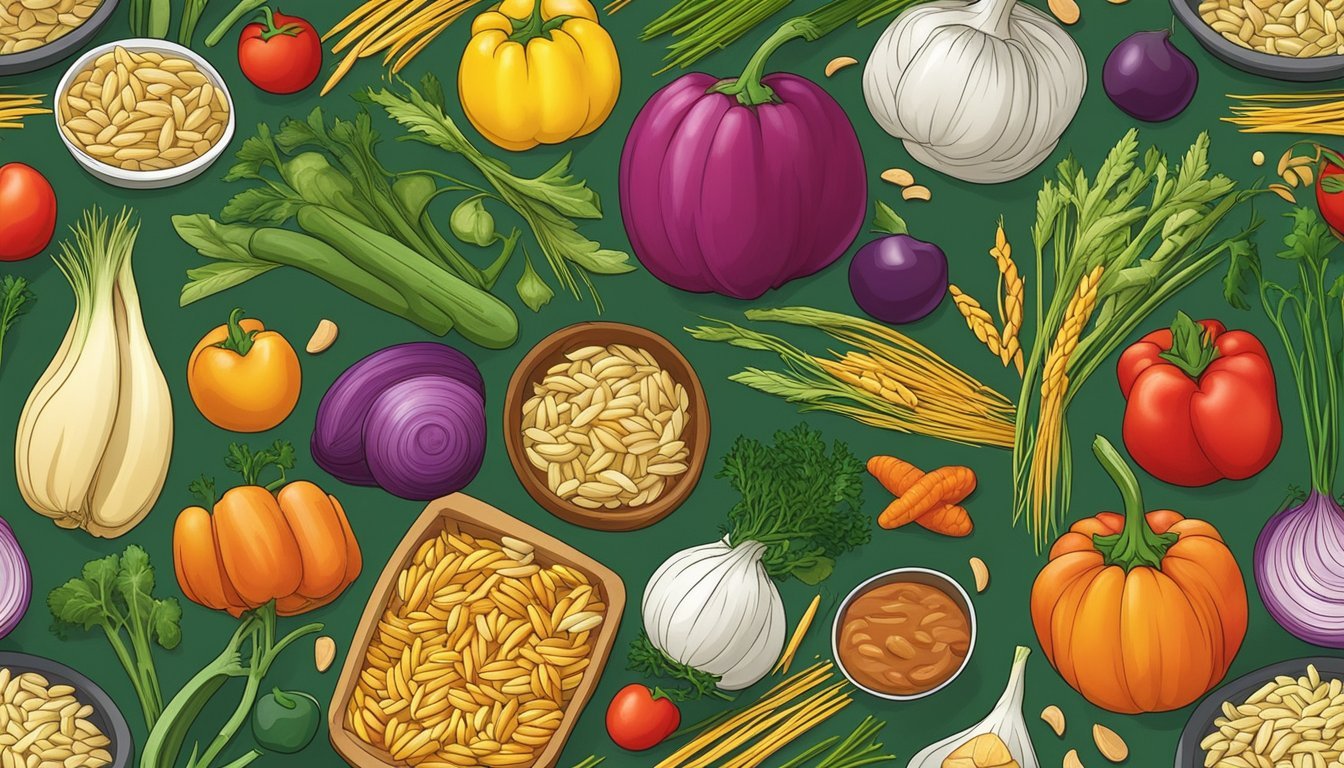Orzo Substitutes
Top Alternatives for Your Pasta Dishes
Orzo, a versatile pasta (What wine goes well with pasta?) that resembles a large grain of rice, is a staple in many cuisines, known for its ability to add a satisfying texture to a variety of dishes. From soups (What wine goes well with soups?) and salads to risottos and pilafs, its distinct shape and quick cooking time make orzo a preferred choice for home cooks and chefs alike.
However, when orzo is unavailable, or for those seeking alternative grains and pastas for dietary needs or flavor preferences, there are numerous substitutes that can be used. Options range from rice and small pasta shapes like acini de pepe to whole grains like quinoa and barley, each bringing their own unique textures and nutritional profiles to dishes. These alternatives not only provide a culinary solution but also allow individuals to explore different ingredients and expand their palate.
Choosing the right substitute for orzo depends on the desired outcome of the dish. For a similar size and texture, small pasta shapes may be preferred, while grains like quinoa offer a nutritious boost and a slightly different mouthfeel. Understanding the characteristics of these substitutes ensures that the essence of the original dish is maintained, even with a different key ingredient.
Understanding Orzo
Orzo is a form of pasta that is a staple in Italian cuisine, known for its rice-like shape and versatile texture and flavor.
Origin of Orzo
Orzo, meaning "barley" in Italian due to its grain-like appearance, is a small, rice-shaped pasta that originated in Italy. Despite its resemblance to grain, it is indeed made from semolina, a type of wheat flour.
Orzo in Italian Cuisine
Orzo holds a notable place in Italian cuisine. It's found in a variety of dishes, from soups and salads to being served as a side dish or incorporated into main courses. This pasta's ability to absorb flavors makes it an ideal component in diverse culinary preparations.
Texture and Flavor of Orzo
The texture of orzo can be described as firm and slightly chewy when cooked al dente, a quality that is highly valued in Italian pasta dishes. Additionally, orzo has a subtle, nutty flavor which becomes a perfect backdrop that enhances the savory and sometimes creamy elements of the dishes it accompanies.
Health and Nutrition
When considering substitutes for orzo, it's important to assess both their nutritional benefits and how they align with various dietary needs. Choices range from higher-protein options to those suitable for gluten-free and low-carbohydrate diets.
Nutritional Profile of Orzo
Orzo, a small pasta shaped like rice, provides a blend of carbohydrates and a modest amount of protein, making it an energy-rich food. However, it typically lacks the fiber and nutrients found in whole grain or alternative options. To understand orzo's health implications, one should consider:
Protein Content: Orzo contains approximately 7 grams of protein per cooked cup.
Fiber Content: Traditionally made from white flour, orzo generally offers less fiber than whole grain substitutes.
Dietary Considerations
Substitutes for orzo open up an array of possibilities for individuals with dietary restrictions. Some of these alternatives include:
Gluten-Free Options: Substitutes like quinoa are naturally gluten-free and provide a nutritious alternative for those with celiac disease or gluten intolerance.
Low-Carb Alternatives: Cauliflower rice stands out as a low-carb, low-calorie substitute rich in vitamins and minerals.
Whole Grain Benefits: Brown rice, while similar in texture to orzo, boasts a higher fiber content and a more complex nutrient profile.
Healthy Additions: Quinoa, a pseudo-cereal, is not only gluten-free but also a complete protein, meaning it contains all nine essential amino acids.
It is essential for consumers to select a substitute that not only mimics the texture and cooking properties of orzo but also aligns with their nutritional goals and dietary limitations.
Orzo in Recipes
Orzo, a rice-shaped pasta, is a staple in numerous recipes, from traditional Italian dishes to contemporary soups and salads. Its versatility and quick cooking time make it a popular choice for a variety of culinary applications.
Classic Orzo Dishes
In the realm of classic orzo dishes, Italian Wedding Soup and Pasta e Fagioli stand out. Italian Wedding Soup typically features orzo as a key ingredient among the greens and meatballs, providing a comforting carbohydrate element. Pasta e Fagioli, or 'pasta and beans,' is a hearty Italian stew that often incorporates orzo for its texture and ability to soak up the flavorful tomato-based broth—all while complementing the beans and vegetables.
Recipes for these classic dishes call for orzo to be cooked until al dente and then combined with other ingredients, allowing it to maintain its shape and absorb the rich flavors of the broth.
Orzo in Soups and Salads
Orzo's small size and ability to absorb flavors make it an excellent addition to both soups and salads. In soups, orzo adds a pleasant bite and can become a main ingredient that transforms a light broth into a more substantial meal. A well-known example is Italian Wedding Soup, where orzo's presence enhances the overall heartiness.
Salads featuring orzo often rely on its pasta quality to create a dish that's satisfying and complete. As it combines with vegetables, herbs, and dressings, orzo becomes a foundation for a diverse array of textures and tastes. Notably, in Greek or Mediterranean salads, orzo pairs seamlessly with ingredients like feta, olives, and cucumber to provide a satisfying dish that can be enjoyed either warm or cold.
In sum, orzo can be seamlessly integrated into both classic and modern recipes, providing texture, flavor absorption, and a sense of completeness in a variety of dishes. Whether it's the star in a traditional stew or a supportive element in a chilled salad, orzo's culinary flexibility is evident.
Seeking Orzo Substitutes
When exploring alternatives to orzo, individuals may be motivated by dietary restrictions, the need for gluten-free options, or simply a desire to experiment with different textures and flavors in their recipes.
Reasons for Substituting Orzo
Orzo, a small, rice-shaped pasta, is a popular ingredient in various dishes, but there are occasions where a substitute is necessary. Dietary restrictions are a common reason; for instance, someone with gluten intolerance or celiac disease requires a gluten-free option since traditional orzo is made from wheat. Additionally, those with allergies to specific grains used in orzo production may also need an alternative.
Individuals adhering to particular diets or lifestyles that limit the consumption of certain grains might seek out orzo substitutes that fit within their dietary parameters. For example, whole grains may be preferred over refined grains for their nutritional benefits. Here’s a brief overview of suitable orzo substitutes:
Quinoa: A protein-rich, gluten-free grain that works well as a nutritious substitute for orzo.
Couscous: Available in different sizes, couscous can resemble the texture of orzo, though it's not gluten-free.
Brown Rice: Offers a chewy texture, nutty flavor, and it’s a whole grain providing more fiber.
Pearl Barley: While it contains gluten, it's high in fiber and works well in soups and stews.
Acini De Pepe: A small, round pasta similar in size to orzo and suitable for salads and soups.
For those requiring a gluten-free substitute, it's essential to choose options like quinoa or brown rice, ensuring the alternative aligns with their dietary needs.
Grain-Based Substitutes
Grain-based alternatives to orzo can offer a variety of textures and nutritional benefits, from the chewiness of rice varieties to the distinct flavors of other grains like quinoa and barley.
Rice Varieties as Substitutes
Brown Rice: A whole grain that provides a chewy texture and a nutty flavor. Brown rice is a nutritious option rich in fiber.
White Rice: Can be a suitable replacement with a softer texture, but it is less nutritious than brown rice.
Wild Rice: Offers a robust, earthy flavor and a firm texture, quite distinct from orzo but it can add an interesting dimension to a dish.
Arborio Rice: Typically used in risotto, Arborio rice has a creamy, starchy quality that can mimic orzo's texture in some recipes.
Rice can come in various forms, and the choice between brown, white, wild, or Arborio rice should depend on the desired flavor and nutritional value.
Other Grain Alternatives
Pearl Barley: It is chewy and possesses a pasta-like consistency. Although not gluten-free, it provides a rich source of fiber and other nutrients.
Farro: An ancient grain with a dense and chewy texture, offering a nutty flavor and is similar to orzo in terms of how it holds up in dishes like salads and soups.
Quinoa: A gluten-free alternative that stands out as a complete protein source and is adaptable to a wide variety of dishes.
Couscous: While not a grain but a tiny pasta, its quick cooking time and size make it a close substitute. Israeli couscous, also known as pearl couscous, has a larger size and a chewier bite, which can provide a texture more akin to orzo.
Selecting from these grain alternatives relies on dietary preferences and the specific qualities one is looking to replicate in their dish, such as texture or flavor.
Pasta Substitutes
When seeking alternatives to orzo, one should consider pasta substitutes in two categories: small pasta alternatives for similar size and texture, and gluten-free pasta options for dietary restrictions.
Small Pasta Alternatives
Small pasta types like ditalini, acini de pepe, and broken spaghetti mimic orzo's size, making them suitable for soups and salads. Here are specific types and their uses:
Ditalini: Small tube-shaped pasta often used in soups and stews.
Acini de Pepe: Tiny, peppercorn-like pasta ideal for light soups and cold salads.
Broken Spaghetti: Handy for a texture akin to orzo in soups and risottos when broken into small pieces.
Small Elbow Macaroni: A versatile option that works well in salads and casseroles.
Alphabet Pasta: A fun choice for soups, especially favored in kids' meals.
Fregola: Toasted pasta from Sardinia similar to large couscous, great for salads and side dishes.
Farfalle Pasta: Also known as bow-tie pasta, can be used whole or broken into smaller pieces for various dishes.
Gluten-Free Pasta Options
For those adhering to a gluten-free diet, substitutes like gluten-free macaroni or gluten-free pasta shapes are available. Examples include:
Gluten-Free Macaroni: Made from alternative flours such as rice, corn, or quinoa.
Gluten-Free Pasta Shapes: Come in various forms, ensuring there is a suitable option for every recipe need.
Legume-Based Substitutes
Legume-based substitutes offer a nutritional alternative to orzo with benefits such as high fiber and protein content. These substitutes provide a range of textures and flavors that can complement various dishes.
Lentils as a Substitute
Lentils are an excellent substitute for orzo due to their quick cooking time and high nutritional value. Unlike other legumes, lentils do not require soaking prior to cooking—simply rinse them under cold water until clear. Green lentils maintain their shape well during cooking, making them ideal for salads and side dishes where orzo might be used.
Cooking instructions:
Rinse 1 cup of green lentils.
Combine with 3 cups of water or broth.
Simmer until tender.
Other Legumes
While lentils are a common choice, other legumes can also serve as suitable substitutes for orzo in a variety of recipes. Each legume brings its unique texture and taste, expanding the culinary possibilities.
Examples of legume substitutes:
Chickpeas: Firm texture and nutty flavor, ideal for heartier dishes.
Black Beans: Rich and earthy, perfect for Mexican-inspired recipes.
Split Peas: Soft texture after cooking, works well in purees and soups.
Nutritional comparison: (per 1 cup cooked)
Legume Protein Fiber Calories Lentils 18g 16g 230 Chickpeas 15g 13g 269 Black Beans 15g 15g 227 Split Peas 16g 16g 231
To summarize, legume-based substitutes like lentils and other beans provide a nutritious and flavorful alternative to orzo pasta, fitting a variety of dietary preferences and recipes.
Vegetable Alternatives
When looking for a low-carb and healthy substitute for orzo, vegetable alternatives offer not only nutritional benefits but also cater to various dietary preferences.
Cauliflower Rice and Other Veggies
Cauliflower Rice: This is a highly favored low-carb alternative to orzo. One can easily make cauliflower rice by pulsing cauliflower florets in a food processor until it resembles the size and texture of rice grains. It is versatile in use, from stir-fries to salads, and can be sautéed or steamed to create a fluffy texture akin to orzo.
Pros:
Low carbohydrate content
Rich in vitamins C, K, and B6
High in fiber
Preparation:
Grate or process cauliflower into granules
Cook with a small amount of oil over medium heat for 5-7 minutes
In addition to cauliflower rice, a variety of vegetables can be chopped or processed to mimic the size and texture of orzo. These include broccoli rice, finely chopped zucchini, and spiraled vegetables. They not only provide a similar look when integrated into dishes but also enhance the nutritional profile by including more vegetables in the diet.
Cooking with Substitutes
When traditional orzo is not available, several alternatives can offer similar results in various recipes. Substitutes can maintain the integrity of the dish while adding distinct textures and flavors.
Quinoa serves as a healthy alternative, fitting well in salads and providing protein. Its cooking time aligns with orzo, making it a convenient substitute. For a risotto-style dish, Arborio rice, known for its creamy texture, is an excellent choice. It takes a bit longer to cook than orzo, but the result is a rich, satisfying dish.
In soups, options such as Moroccan couscous or Ditalini pasta work well due to their size and ability to absorb flavors. Couscous is quicker to prepare, often ready within minutes, whereas Ditalini, with its small tube shape, can take a similar cooking time to orzo.
Brown rice, particularly the short-grain variety, offers a chewy texture and is a wholesome, gluten-free option compatible with an array of recipes. Though its cooking time is notably longer, typically around 30-40 minutes, its nutritional profile can be a decisive factor for healthy meal planning.
Substitute Cooking Time Best Used in Texture Notes Quinoa 10-15 mins Salads, Pilafs Light, fluffy Arborio Rice 20-30 mins Risotto Creamy Couscous 5-10 mins Soups, Salads Small, grainy Ditalini 10-12 mins Soups, Stews Small, tubular Brown Rice 30-40 mins General use Chewy, hearty
Each substitute brings a unique aspect to the dish, allowing for flexibility and creativity in the kitchen without compromising taste or texture.
Customizing Flavor and Texture
When seeking orzo substitutes, one should consider both flavor profile and texture to ensure that the dish maintains its intended character. Substitutes can range dramatically in these aspects, and choosing the right one can elevate a recipe.
Grains with a Nutty Flavor: Brown rice is often selected for its nutty flavor and chewy texture. It is a whole grain which means that it also brings additional fiber and nutrients to a dish. Quinoa, a gluten-free alternative, also has a distinct nutty profile and adds a pleasant crunch.
Italian Pastas for Creamy Consistency: For dishes requiring a creamy consistency, similar to that of orzo, smaller pasta shapes like Acini di Pepe or Ditalini are excellent choices. They cook to a comparable size and maintain a chewy texture, blending well with creamy sauces.
Substitute Flavor Profile Texture Notes Brown Rice Nutty Chewy Whole grain, more fibrous Quinoa Nutty Crunchy Gluten-free, protein-rich Acini di Pepe Neutral Chewy Similar in size to orzo Ditalini Neutral Firm Works well in soups and salads
When modifying a recipe, one must be mindful of the cooking times and liquid absorption rates as they vary between these alternatives. The chef's intent is to match the substitute as closely as possible to orzo's characteristics or to introduce a complementary profile that will enhance the overall dish.












